Stainless Steel in Contact with Other Metallic Materials
Reprinted from Euro Inox with permission.
Translated and adapted from:
ARLT, N. / BURKERT, A / ISECKE, B., Edelstahl Rostfrei in Kontakt mit anderen Werkstoffen (Merkblatt 829), Düsseldorf, Informationsstelle Edelstahl Rostfrei, 4th edition 2005
Photo credits:
Atomium asbl / vzw, Brussels (B)
Centro Inox, Milan (I)
Bundesanstalt für Materialprüfung und -forschung, Berlin (D)
David Cochrane, Sidcup (UK)
Benoît Van Hecke, Hasselt (B)
Outokumpu, Tornio (FIN)
Thomas Pauly, Brussels (B)
Christoph Seeberger, Munich (D)
ThyssenKrupp Nirosta GmbH, Krefeld (D)
Schöck Bauteile GmbH, Baden-Baden (D)
Viega GmbH & Co. KG, Attendorn (D)
Table of contents
1 Introduction
2 The principles of galvanic corrosion
3 Relevant factors and examples
3.1 Electrolyte resistance
3.2 Wetting duration and environments
3.3 The kinetics of electrode reactions
3.4 Cathode and anode area
4 Practical experience in different applications
4.1 Water and sewage treatment
4.2 Components in atmospheric conditions
4.3 Stainless steel in building and construction
4.4 Stainless steel in transport applications
4.5 Frequently asked questions
5 Preventing galvanic corrosion
6 Literature
1 Introduction
Complex design requirements can make it necessary to combine different metallic materials within the same component. Also, chance combinations can often be found, governed only by the availability of, for instance, fasteners or shims. In certain circumstances, such mixed-material designs can lead to corrosion in one of the partner materials. This phenomenon includes galvanic corrosion1, in which two different metals form a galvanic couple.
As a result of the formation of galvanic elements, accelerated corrosion of the less noble material can occur. The latter may then suffer a corrosion rate far higher than that to be expected without any contact with the nobler partner metal. Corrosion-related damage such as unacceptable deterioration of appearance, leaking tubes or failing fasteners can drastically reduce the service life of a component and lead to premature replacement. In most technical applications, stainless steel has the more positive corrosion potential of the metals in contact; hence there is usually a corrosion hazard for the partner material.
The risk of galvanic corrosion occurring depends, however, on a multitude of factors. Besides the materials used, environment and design are crucial. It is therefore difficult to make a priori judgments about the compatibility of materials. The present publication describes the principles of galvanic corrosion and the main parameters that allow designers to estimate corrosion risk.
1Accelerated corrosion of a metal, due to the effect of a corrosion element. Other factors include concentration elements, aeration elements and active/passive elements.
2 The principles of galvanic corrosion
For galvanic corrosion to occur, there must be:
- different corrosion potentials of the metals within a given system;
- a conductive connection between the two metals;
- an electrically conductive humidity film (electrolyte) connecting both metals
Figure 1 shows the three prerequisites in graphic form.
If galvanic corrosion occurs, the less noble material – the anode – is preferentially attacked whilst the more noble material – the cathode – is even protected against corrosion. In fact, the principle of cathodic protection is based on sacrificial anodes providing protection from corrosion.
The contact of two metals with different potentials in an electrically conductive solution leads to a flow of electrons from the anode to the cathode. The electro-chemical reactions are the same as those that would naturally occur in the metal in isolation; however, the corrosive attack on the anode is greatly accelerated. In some cases, the formation of galvanic elements can lead to corrosion in materials that would otherwise be corrosion resistant in the environment in question. This can be the case for passive materials such as aluminium, which can be locally polarised in a certain environment. In such cases, localised corrosion phenomena such as crevice corrosion or pitting corrosion can be observed, which would not have occurred without the shift in potential caused by the formation of galvanic elements.

Contrary to widespread belief, the difference of potential in an electrochemical cell alone is not a good indicator of the actual risk of galvanic corrosion. It only indicates whether or not such a risk has to be taken into account. In this context, it should be remembered that the numerous published tables of the standard potentials of metals only provide an approximation of differences of potential. The decisive factor is not the difference of potential observed under standardised experimental conditions but rather the actual difference of potential under real operating conditions. This is why empirical tables of galvanic series have been produced for typical environments such as sea water. These position the potential of various metals in a given environment (Figure 2).
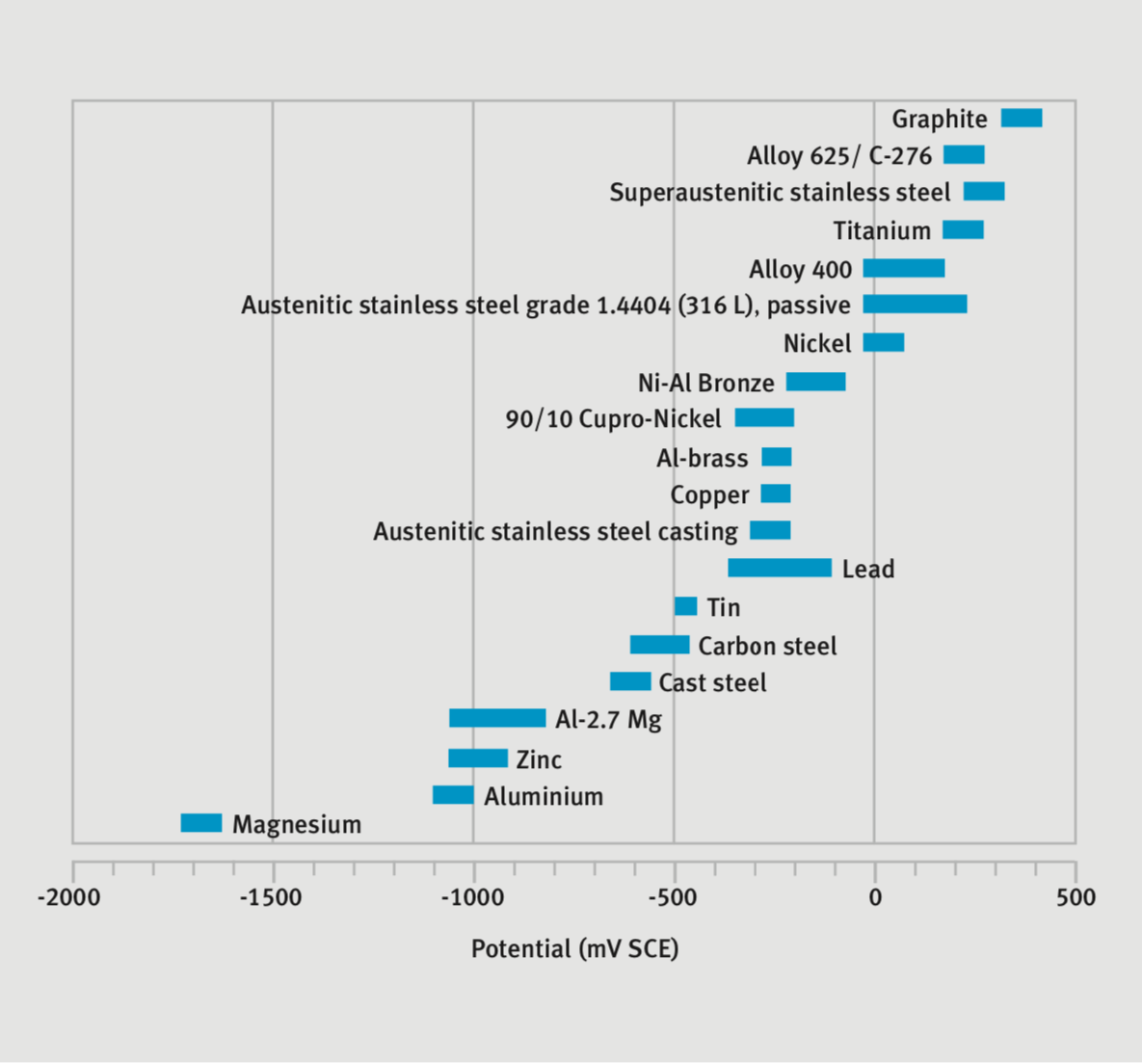
Awareness of the prerequisites of galvanic corrosion and a proper understanding of the examples in Figure 3 make it possible to determine preventive action, which will be discussed in section 5.

3 Relevant factors and examples
According to Faraday’s law, electro-chemical corrosion processes are directly related to charge transfer, i.e. the flow of currents. Currents or current densities are therefore frequently used to measure corrosion. If the conditions for galvanic corrosion are met in principle, the total corrosion current Itot is composed of a partial current from self- corrosion Is (i.e. the part of the corrosion that is independent of contact with other materials) and a partial cell current Iel (i.e. the part of the corrosion due to the cell current between the partner materials (Equation 1).
Itot = Is + Iel (Equation 1)
Intensity of element corrosion is determined by the difference of potential between the two metals ΔU), the electrolyte resistance (Rel) and the polarisation resistance at the anode (Rp,a) and cathode (Rp,c) respectively (Equation 2).
Iel = ΔU / (Rel + Rp,a + Rp,c) (Equation 2)
From this equation, inferences can be drawn concerning the factors that determine galvanic corrosion. These factors are critical in determining whether or not metallic corrosion will become a technically relevant problem. The effects of these factors will therefore be discussed individually.
3.1 Electrolyte resistance
The risk of galvanic corrosion diminishes with increasing electrolyte resistance. This is because the reach of the galvanic current is reduced and the shift of potential at the anode is limited, as illustrated in Figure 4.
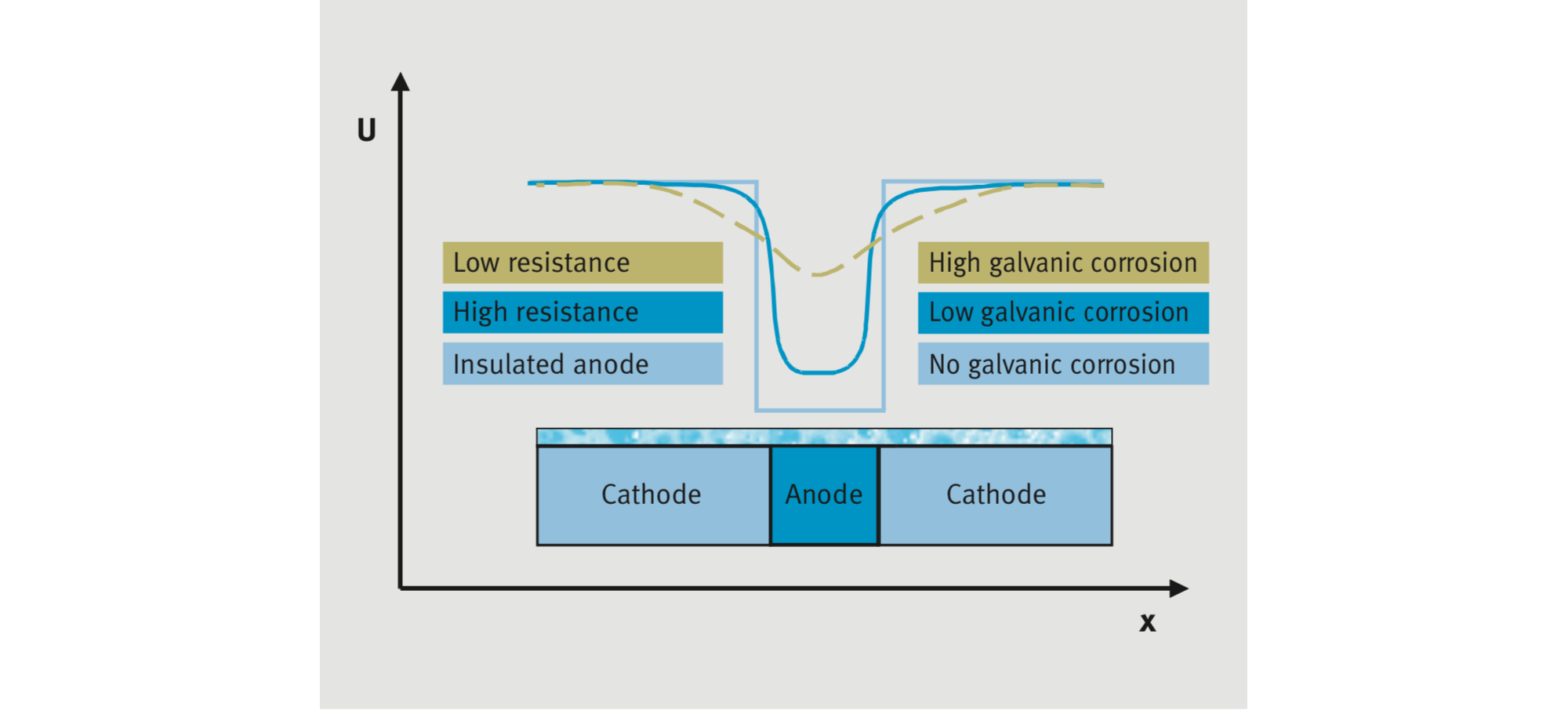
Measurement of potential at the surface identifies, in the case of an insulated anode, the position of the respective potentials of cathode and anode, independently of each other. In the transition area, a marked jump in potential is observed. If an electrically conductive connection between cathode and anode exists, a low polarisation of the anode towards higher values is observed in electrolytes with high resistance (such as water films resulting from condensation).
In the case of electrolyte films of low resistance (salt water), a very strong polarisation is measured. The higher the polarisation, the higher the corrosion rate of the anode if the material is active or the higher the probability of reaching critical (corrosion-initiating) potential if the material is in its passive state. Table 1 shows specific conductivity values of various types of water.
Table 1: Typical values of specific conductivity in different types of water.
| Environment | Specific conductivity in (Ω * cm)-1 |
|---|---|
| Pure water | 5 * 10-8 |
| Demineralised water | 2 * 10-6 |
| Rain water | 5 * 10-5 |
| Drinking water | 2 * 10-4 - 1 * 10-3 |
| Brackish river water | 5 * 10-3 |
| Sea water | 3,5 * 10-2 - 5 * 10-2 |
3.2 Wetting duration and environments
There is a strong interaction between electrolyte resistance and duration of wetting. This is of critical importance wherever components are not permanently wetted by watery liquids. As explained in the description of the prerequisites of galvanic corrosion, the electrolyte film plays a key role. Without such a film, no galvanic corrosion can occur. This implies that, in practice, any combination of metallic materials is uncritical from a corrosion point of view if no electrolyte film is present. This is typical of interiors without condensation. In lighting fixtures or interior-decoration components, virtually any material combination can be used, in normally aerated and heated environments, without restrictions in terms of corrosion risk (Figure 5).
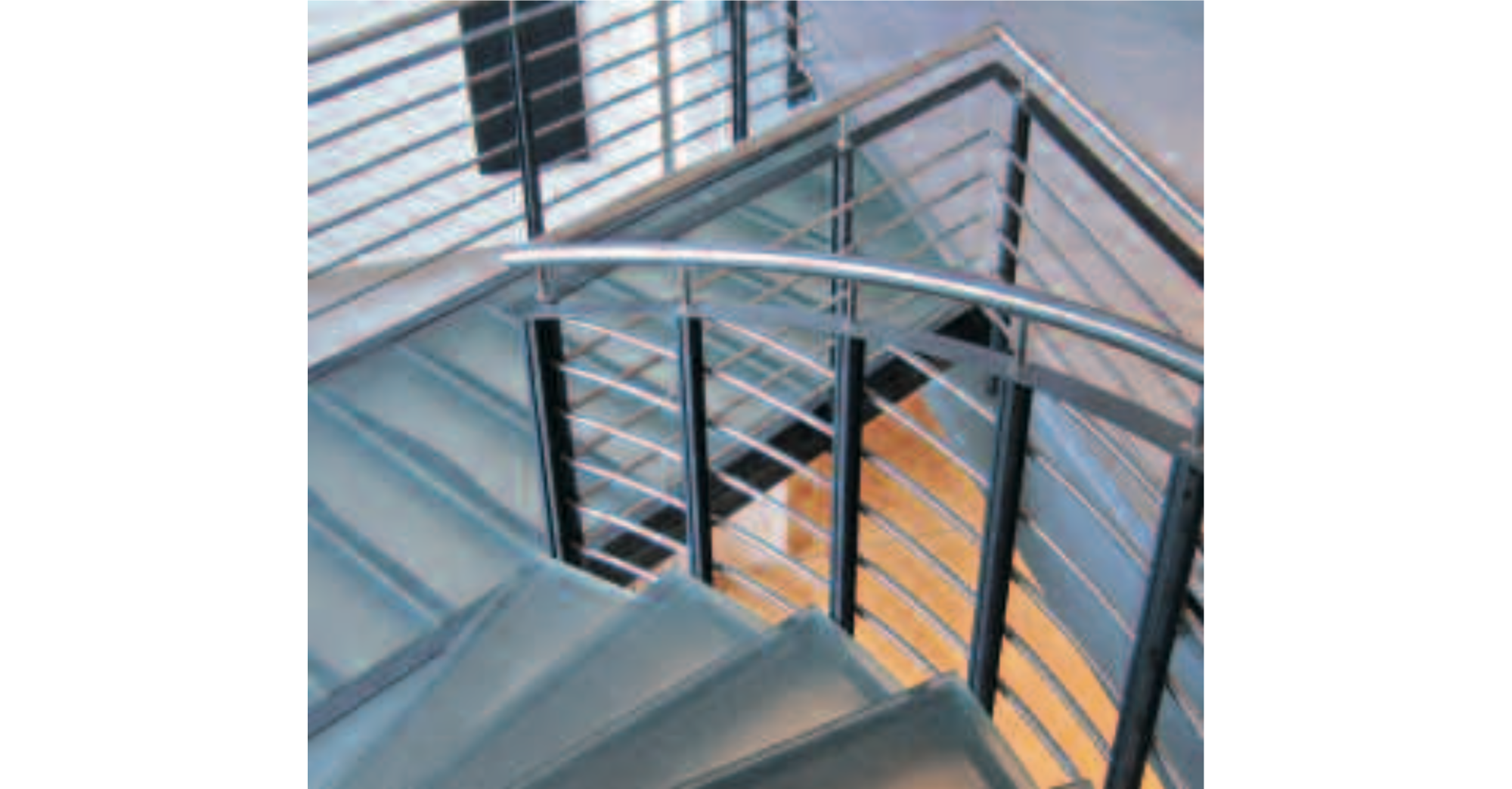
Both length of exposure and electrolyte resistance are strongly dependent on local conditions. In marine, industrial or indoor swimming pool environments, the probability of galvanic corrosion is significantly higher than in rural atmospheric conditions. Figure 6 shows the influence of the environment on the corrosion rate of zinc, with and without contact with stainless steel. It demonstrates that the proportion of cell corrosion (i.e. the difference between the corrosion rates) exceeds that of self-corrosion (i.e. the corrosion rate of zinc without any contact with the stainless steel) in a coastal atmosphere and in a sea-water splash zone.
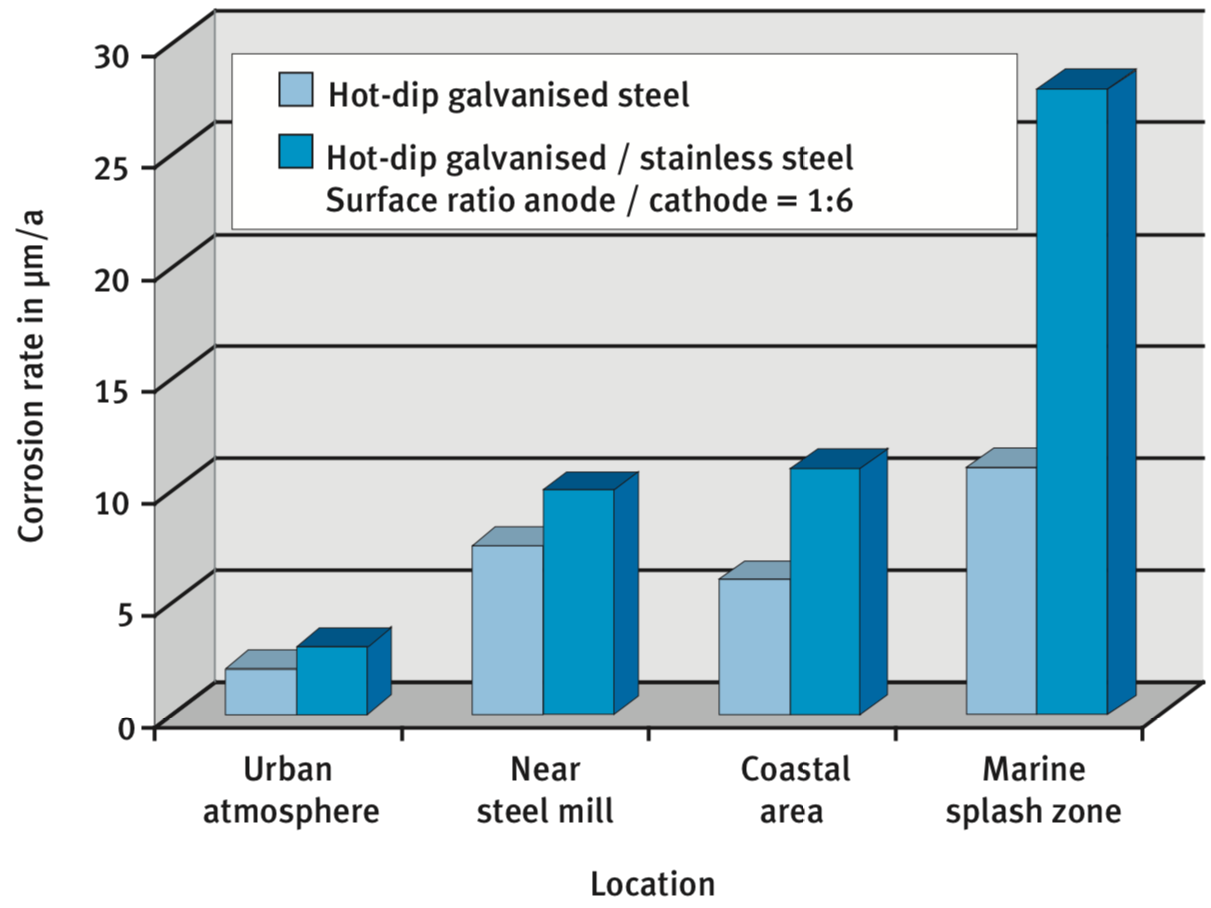
Besides ambient atmosphere, design details play a decisive role. Factors that help humidity films to dry quickly (adequate aeration, prevention of crevices, free drainage of rainwater) reduce corrosive attack. Permanently humid areas in crevices or covered areas, stagnant water and soiled surfaces can considerably accelerate galvanic corrosion.
3.3 The kinetics of electrode reactions
The kinetics of electrode reactions are expressed in Equation 3 by the polarisation resistance values of the anode and the cathode. Differences in potential as low as 100 mV can lead to corrosion, while metals with considerably higher differences of potential can be joined without difficulty. In fact, difference of potential provides no information about the kinetics of galvanic corrosion. The kinetics of the reaction depend on the metal. Titanium, for instance, reduces dissolved oxygen much less readily than copper. This explains why carbon steel corrodes more quickly in contact with copper than with titanium, although the latter has higher positive potential than copper.
In this context, the formation of corrosion layers also plays a decisive role. These can significantly change the potential of a material and be an obstacle to the anodic and/or cathodic partial reaction.
3.4 Cathode and anode area
A factor in the calculation of cell current density, iel (area-related cell current) is the ratio of cathodic (Ac) and anodic (Aa) surface areas. It strongly influences the velocity of galvanic corrosion (Equation 3).
iel = Ac / Aa · ΔU / (Rel + Rp,a + Rp,c) (Equation 3)
As long as the cathodic surface area (the more noble metal of the galvanic couple) is very small in comparison to the anodic surface area (the less noble metal) no change in corrosion behaviour is observed. This situation is shown in Figure 7.

Typical examples can be found when stainless steel fasteners are used on aluminium or galvanized carbon steel components. Two practical applications are shown in Figure 8. Even in corrosive conditions, this material causes virtually no galvanic corrosion.

Under atmospheric conditions, it is sometimes difficult to quantify the active proportions of anodic and cathodic surfaces. For a practical evaluation, this may, however, not be necessary. Normally it is sufficient to consider the system in general. In material combinations, fasteners should always be made of the more noble material, so the cathodic surface is small.
The opposite situation, however, can cause a problem. If a small anode is surrounded by a large cathode, galvanic corrosion may occur, as shown in Figure 9.

Typical examples of such a situation are shown in Figure 10. In these cases, it is clear that, under corrosive conditions, the partner metal may suffer accelerated corrosion.
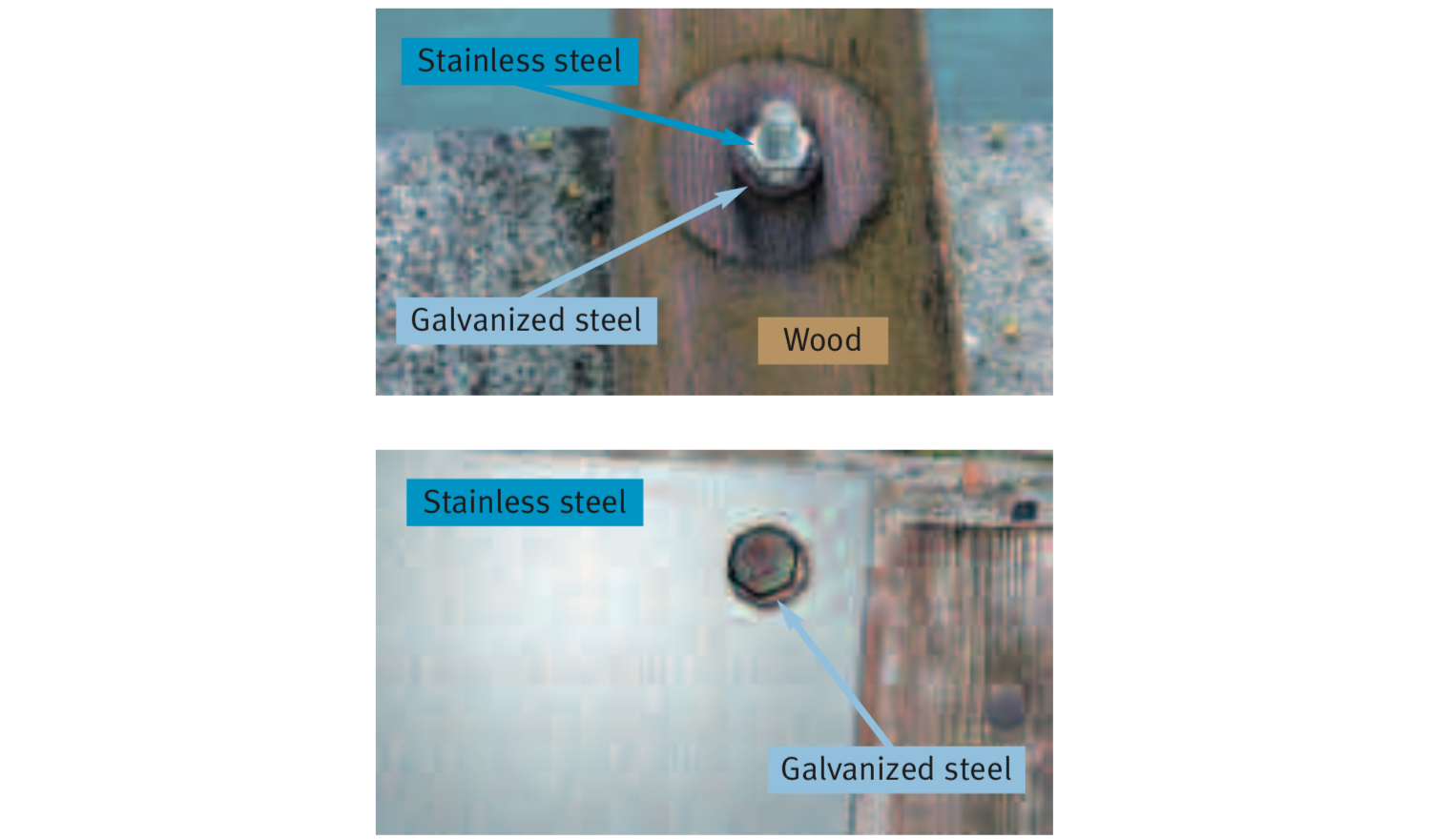
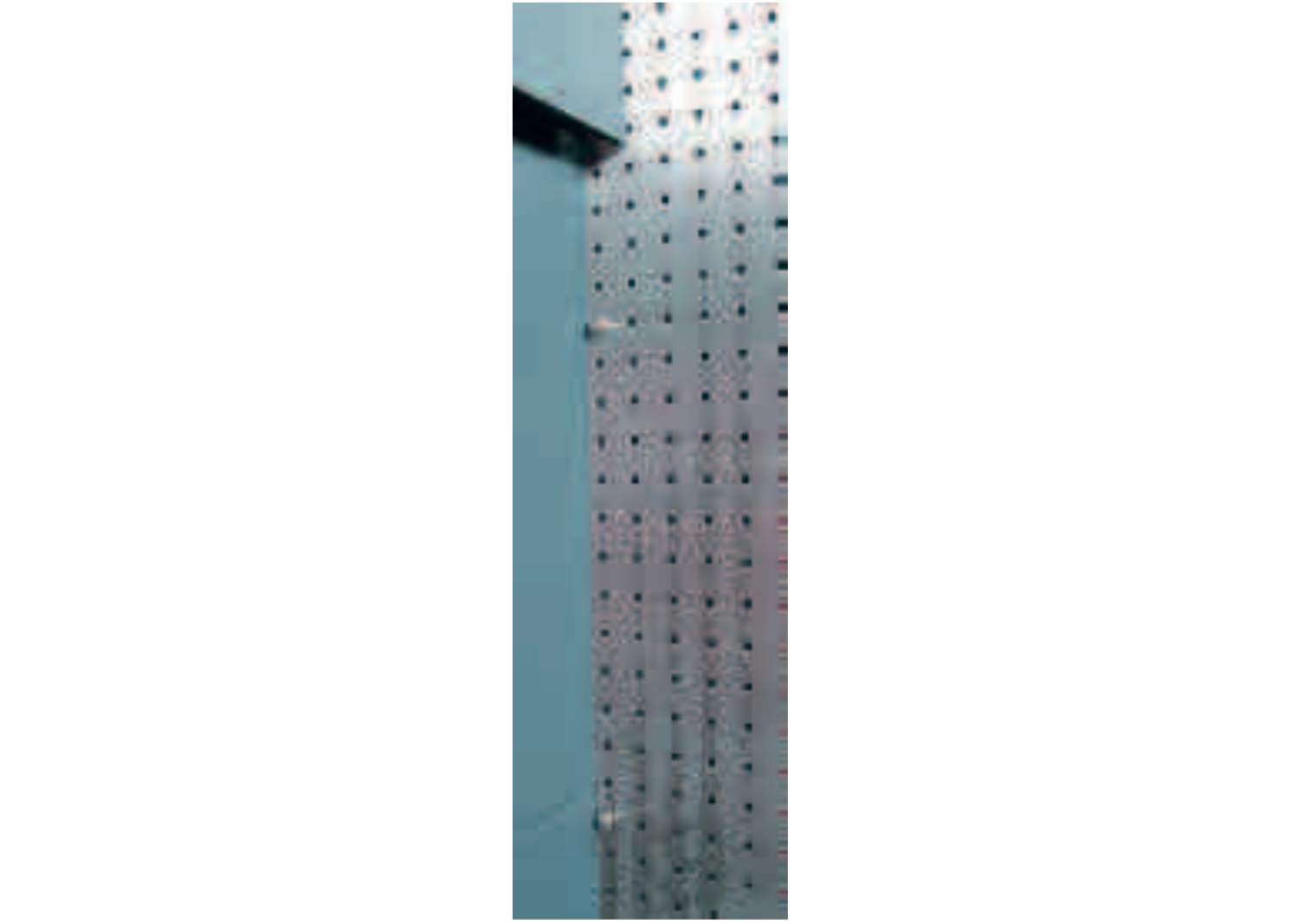
4 Practical experience in different applications
Extensive research and practical experience are available concerning the corrosion behaviour of material combinations involving stainless steel, under different conditions. Some relevant results are shown in Tables 2 to 5. Most results refer to stabilized stainless steel grades with higher carbon content. In principle, the results are transferable to grades with reduced carbon content, such as 1.4307 or 1.4404. Further guidance can be found in the relevant literature, provided the corrosion system is considered as a whole.
Apart from numerical values, experience makes it possible to make some general statements, which will be summarised in the following sections.
Table 2: Corrosion rates of various metallic materials in contact with stainless steel.
| Galvanic | cell | Environment | Area ratio | Corrosion rate (mm/a) |
|---|---|---|---|---|
| 1.4016 | Carbon steel | Drinking water, aerated | 1:1 | 0.47 |
| ,, | Zn 99.9 | ,, | 0.26 | |
| ,, | Al 99.9 | ,, | 0.17 | |
| ,, | CU-DGP | ,, | 0.07 | |
| ,, | Ti | ,, | < 0.01 | |
| 1.4541 | SF-Cu | Artificial sea water | 1:1 | 0.12 |
| ,, | SF-Cu | ,, | 1:10 | 0.07 |
| ,, | SF-Cu | ,, | 10:1 | 1.00 |
| ,, | Carbon steel | ,, | 1:1 | 0,38 |
| ,, | Carbon steel | ,, | 1:10 | 0.25 |
| ,, | Carbon steel | ,, | 10:1 | 1.10 |
| ,, | Zn | ,, | 1:1 | 0.61 |
| ,, | Ti | ,, | 1:1 | < 0.01 |
Table 3: Corrosion rates of ZnCuTi in contact with stainless steel grades 1.4541 and 1.4571 in 0.1 N NaCl (aerated, CO2 saturated, room temperature) according to DIN 50919.
| Galvanic | cell | Area ratio | Corrosion rate (mm/a) |
|---|---|---|---|
| 1.4541 | ZnCuTi | 1:1 1:5 | 4.39 1.43 |
| 1.4571 | ZnCuTi | 1:1 1:5 | 3.88 0.91 |
Table 4: Corrosion rates of different metallic materials in contact with various stainless steels in an aqueous NaCl solution with 5 %vol. NaCl at 35 °C, surface ratio 1:1 (DIN 50919).
| Galvanic cell | Corrosion rate (mm/a) | ||
|---|---|---|---|
| X6CrMo17-1 1.4113 | X2CrTi12 1.4512 | X5CrNi18-10 1.4301 | |
| Carbon steel | 0.62 | 0.66 | 0.69 |
| Hot-dip galvanized steel | 0.51 | 0.51 | 0.55 |
| ZnAl 4 Cu 1 | 0.66 | 0.66 | 0.69 |
| AlMg 1 | 0.15 | 0.29 | 0.29 |
| Cu-DGP | 0.04 | 0.04 | 0.04 |
| CuZn 40 | 0.04 | 0.04 | 0.04 |
Table 5: Corrosion rates of different materials in contact with stainless steel grade 1.4439 in the North Sea (field test), duration 1 year.
| Galvanic cell | Area ratio | Corrosion rate (mm/a) | |
|---|---|---|---|
| 1.4439 | Carbon steel | 1:1 | 0.31 |
| ,, | ,, | 4:1 | 0.75 |
| ,, | ,, | 10:1 | 2.10 |
| 1.4439 | AlMg 4.5 Mn | 1:1 | 0.17 |
| ,, | ,, | 4:1 | 0.26 |
| ,, | ,, | 10:1 | 0.95 |
| 1.4439 | CuNi 10 Fe | 4:1 | 0.07 |
| 1.4439 | CuZn 20 Fe | 4:1 | 0.18 |
4.1 Water and sewage treatment
Depending on its composition, the corrosive effect of water on stainless steel may vary considerably: deionised water without impurities is not corrosive (except at extremely high temperatures). Drinking water and water of similar composition contains moderate concentrations of chloride ions (max. 250 mg/L, according to the Drinking Water Directive). In unfavourable circumstances, these can lead to pitting or crevice corrosion and, under the combined influence of high temperatures and chloride concentration, to stress corrosion cracking. In most cases, austenitic CrNiMo grades such as 1.4401, 1.4404 and 1.4571 are corrosion resistant, if properly fabricated. There are also numerous cases of the successful use of grade 1.4301.
In drinking water, the risk of galvanic corrosion is moderate. For many years, combinations of stainless steel, copper, copper alloys and red brass have been successfully used both for cold-water and hot-water applications in tubes, couplers and tanks, without damage from contact corrosion (Figure 12). While carbon steel can be combined with stainless steel in low-oxygen water, coupling galvanised steel and aluminium alloys risks galvanic corrosion in the latter [2].
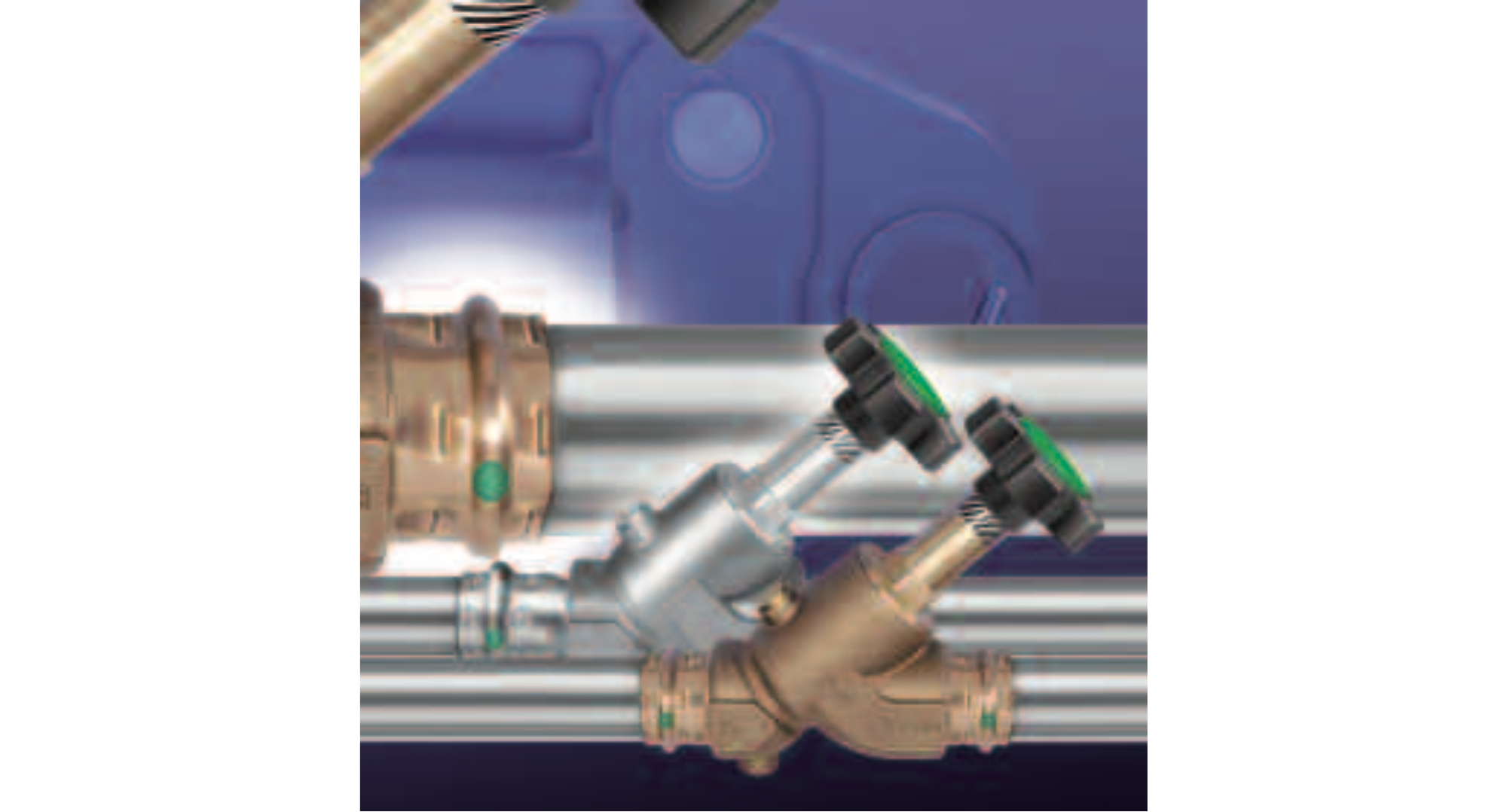
In sewage systems, conditions are less obvious. A wide variety of water compositions is observed, some with high conductivity, and the risk of galvanic corrosion is also increased by the high general corrosiveness of sewage to many materials. Table 6 gives an overview of the compatibility of various materials in aerated sewage. In soldered joints, choosing a corrosion-resistant solder is critical.
Table 6: Compatibility of materials in aerated sewage water.
| Material | with | a | small | area | ||
|---|---|---|---|---|---|---|
| Carbon Steel Cast iron | Zn Galvanized steel | Al | Cu | Stainless steel | ||
| Material | Carbon steel / cast iron | +* | +* | - | 0 / - | +* |
| with | Zn / galvanized steel | - | + | - | 0* | +* |
| a | Al | - | 0 / - | +* | - | +* |
| large | Cu | - | - | - | +* | +* |
| area | Stainless steel | - | - | - | 0 | + |
| Steel in concrete | - | - | - | + | + |
Key: + = good; o = uncertain; - = poor
*Although combining these partner metals only has a negligible influence on the materials, this combination is not recommended because of the high self-corrosion rate of the less noble partner metal.
Sea-water (with typical chloride ion concentrations of about 16,000 mg/L) and similar high-chloride types of water cause high corrosive stress and normally require higher alloyed grades such as EN 1.4462, 1.4439, 1.4539, or 1.4565, or nickel based alloys. Recommendations for preventing the corrosion of various metallic materials in water can be taken from EN 12502, parts 1 to 5 [2]. The risk of galvanic corrosion essentially depends on the conductivity of the water (see section 2). Deionised water is normally uncritical in this respect.
As a highly conductive environment, seawater tends to encourage galvanic corrosion. Not only are parts made of aluminium alloys, zinc or galvanized carbon steel at risk, but also those made of copper or gun metal. Figure 13 demonstrates the influence of cathode/anode ratios on corrosion rates in material combinations involving stainless steel and carbon steel. It is clear that in this highly conductive environment the distance between cathode and anode has no significant influence. Metallic parts can be prone to contact corrosion even if they are relatively distant from each other, provided an electrically conductive connection exists (for instance, via a common earth).
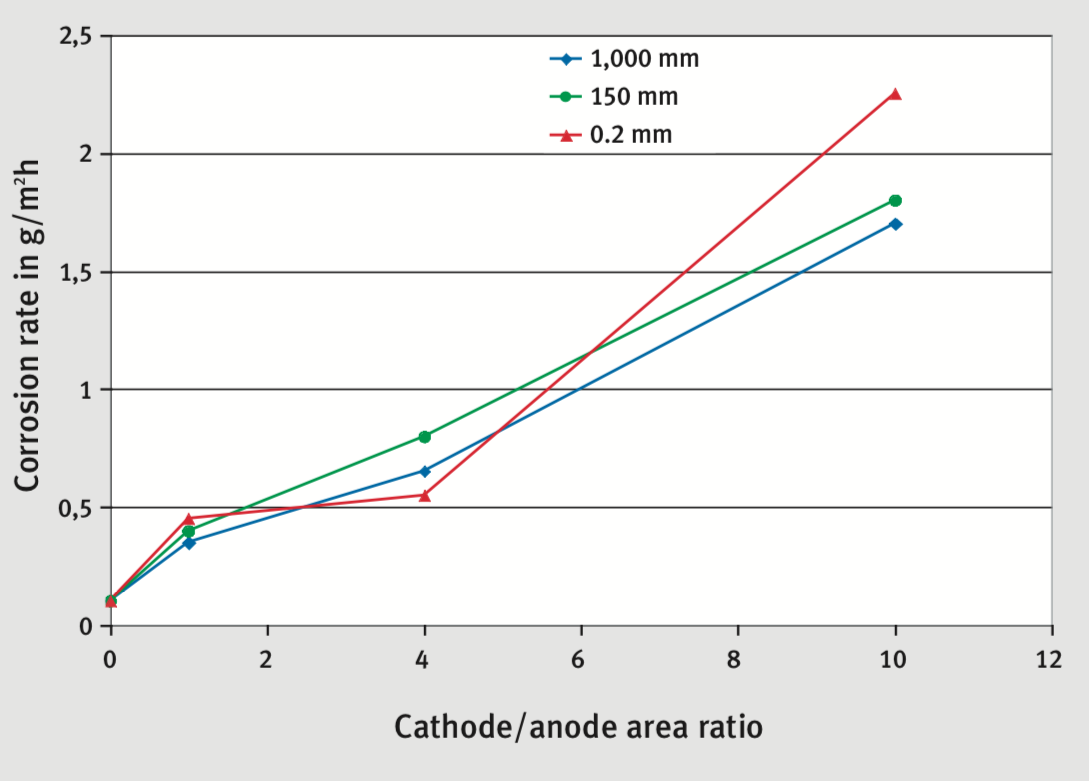
There is a general corrosion risk in water-preparation applications that bring stainless steel into contact with activated carbon, which is commonly used in filtration. In some cases, particles of the filter material can come loose and get into contact with the stainless steel. The large surface area of the filter material can then work as a cathode and shift the polarisation of the stainless steel 200 to 300 mV in the positive direction. This shift can induce crevice and pitting corrosion in ferritic and non-molybdenum-containing austenitic grades, even at low chloride levels. An example of this process is shown in Figure 14. Here, corrosion damage occurred in certain feed water basins of a water works, with an average chloride content of 150 mg/L, specifically affecting the stainless steel fasteners that join the filter-jet base plates to the reinforced concrete. Pitting and crevice corrosion were only observed in those filter pools in which activated carbon was used as a filter material and could come into contact with the fasteners during rinsing operations. As well as the specified 1.4301, 1.4571 and 1.4401 grades being used for the various elements of the fasteners, ferritic stainless steel grade 1.4016 was used by mistake. Not surprisingly, this grade was the most strongly affected by corrosion damage.
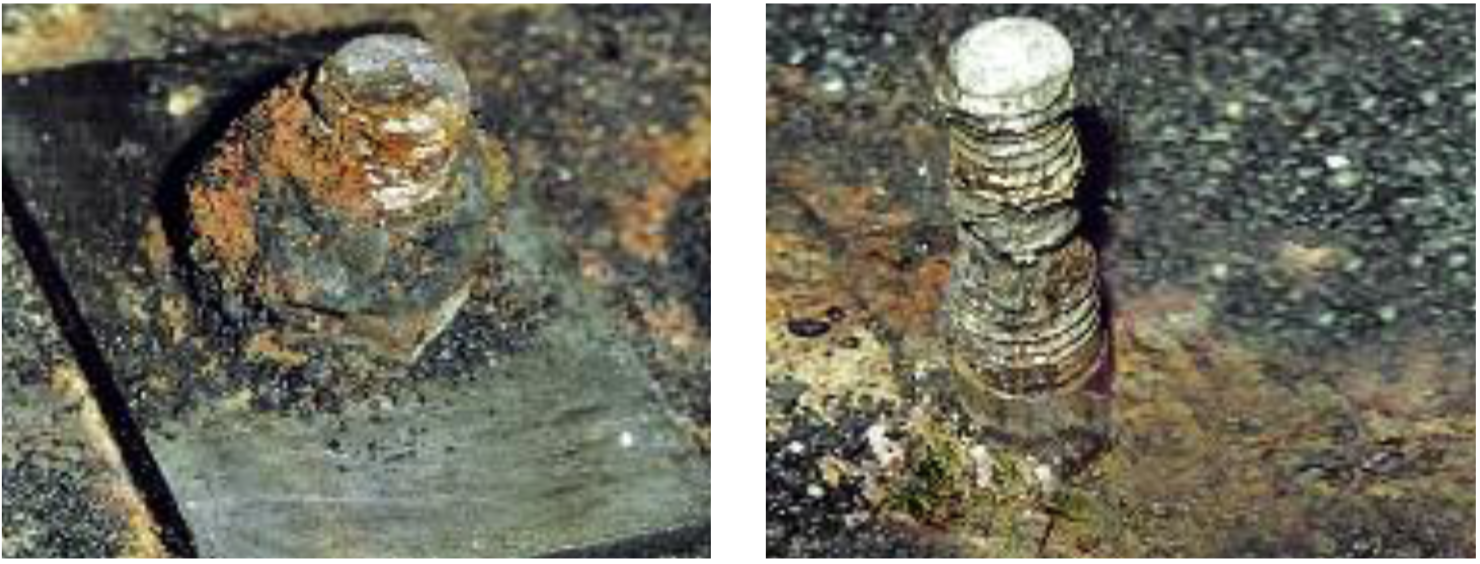
4.2 Components in atmospheric conditions
While an electrolyte is typically present at all times in ducts and containers for aqueous media, this is not necessarily the case for components in ambient air. In such circumstances, corrosion can only occur during exposure to humidity. The surface may not necessarily come into direct contact with rain or splash water. Often, microscopic humidity films may form through absorption of water vapour from ambient air. Also, visible condensation may occur. Dirt and hygroscopic deposits on components can have a significant influence on the duration of humidity. Poorly aerated crevices, for instance under washers or between overlapping sheets, can lead to the virtually permanent presence of humidity. In contrast to corrosion elements in aqueous systems, the formation of elements here may only concern a very limited area. The two materials only influence each other within a very small zone along the contact line, without the larger surface of the partner metal playing a significant role. In these cases, surface ratio only has a limited effect, so the well known surface ratio rules do not apply in the normal way.
Because of the limited reach of the elements in ambient air, covering the stainless steel in the narrow zone along the contact line is usually sufficient to prevent galvanic corrosion.
Permanently wet crevices between stainless steel and a less noble material, such as aluminium or zinc or zinc-coated components, can be problem areas. Elastic joint seals, which fill the crevice, are a proven remedy. Sealants, prone to embrittlement and cracking within the crevice can, however, make the situation worse.
Table 7 provides information on the compatibility of various materials under atmospheric conditions.
Table 7: The compatibility of materials in ambient air.
| Material | with | a | small | area | ||
|---|---|---|---|---|---|---|
| Carbon Steel Cast iron | Zn Galvanized steel | Al | Cu | Stainless steel | ||
| Material | Carbon steel / cast iron | +* | - | - | +* | +* |
| with | Zn / galvanized steel | +* | + | + | 0 | + |
| a | Al | 0 / - | 0 | + | 0 / - | + |
| large | Cu | - | - | - | + | + |
| area | Stainless steel | - | - | 0 / - | + | + |
Key: + = good; o = uncertain; - = poor
*Although combining these partner metals only has a negligible influence on the materials, this combination is not recommended because of the high self-corrosion rate of the less noble partner metal.
4.3 Stainless steel in building and construction
The use of stainless steel in building and construction is on the increase. Beyond its architectural design possibilities, the material’s easy fabrication and high corrosion resistance are of paramount importance. Stainless steel is used for visible surfaces, structural components and fasteners (such as screws). The most usual grades are of the 18/8 CrNi and 17/12/2 CrNiMo types – the latter particularly for high-quality surfaces in industrial and urban environments or inaccessible structural components such as facade supports. Having to join stainless steel to other metallic materials may be difficult to avoid. Corrosion behaviour critically depends on design factors: on surface areas wetted by rain or condensation, in interior or exterior environments, the interaction of the metals does not reach far and becomes relevant only in the immediate area along the contact line.
In parts exposed to external atmosphere and condensation, the duration of wetting is the key factor. Occasional and short-term exposure to humidity films does not normally lead to galvanic corrosion. Hence, design factors are all-important. Factors favouring the rapid drying of humidity films (good aeration, prevention of crevices, free drainage of rainwater, smooth surfaces) reduce corrosion attack. However, permanently damp areas (in crevices or sheltered areas), stagnant water and dirt can greatly increase the risk of galvanic corrosion. Weathered parts from which dirt is removed by rain and which are sufficiently aerated to dry quickly are less vulnerable to corrosion than recessed areas, which, although protected from rain, remain damp over an extended period and allow dirt to accumulate.
Although surface ratios are only of limited value in identifying corrosion risk, designs with small anodes and relatively large cathodes should generally be avoided. Unless this principle is observed, galvanic corrosion is a possibility, even in well-aerated areas.
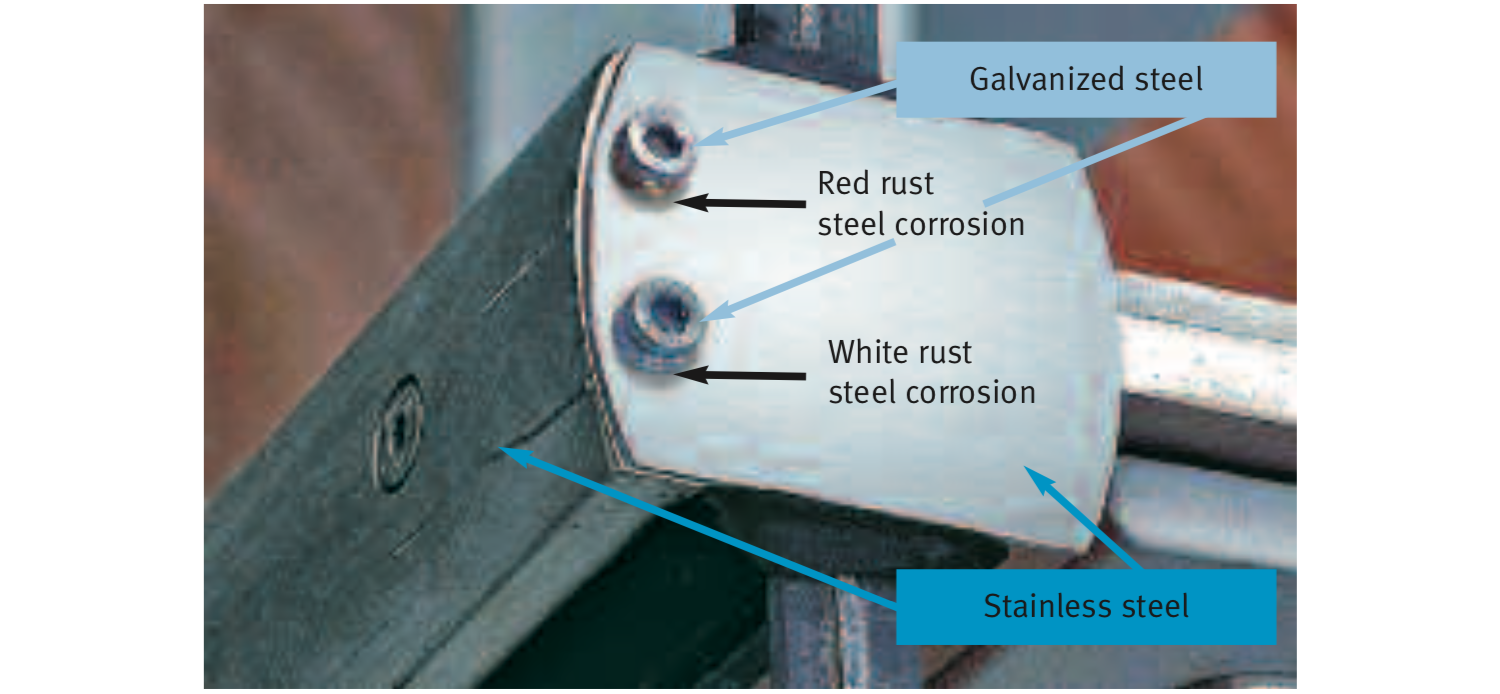
Figure 15 shows an example. The upper end of horizontal stainless steel sections in a steel and glass facade was covered using two galvanized screws. Starting from the crevice between the lid and the screw, these show marked white rust formation and even, to some extent, corrosion of the base material. These phenomena were observed after only about 12 months of service, which indicates that this is not a durable solution. Stainless steel fasteners should be substituted for the galvanized screws.
In roofing technology – both in new build and renovation – stainless steel is predominantly used for fasteners which are in contact with other metallic materials or materials with metallic coatings. Due to the favourable ratio of anodic and cathodic surfaces, there is generally no corrosion risk in such material combinations. In roof repairs, it is not uncommon to join larger surfaces of stainless steel with other metals. Such combinations can also be considered uncritical unless the ratio between the stainless steel part and the aluminium or galvanized part significantly exceeds 1:1.
Figures 17 to 20 show practical examples of the risk of galvanic corrosion in the building envelope being efficiently prevented.
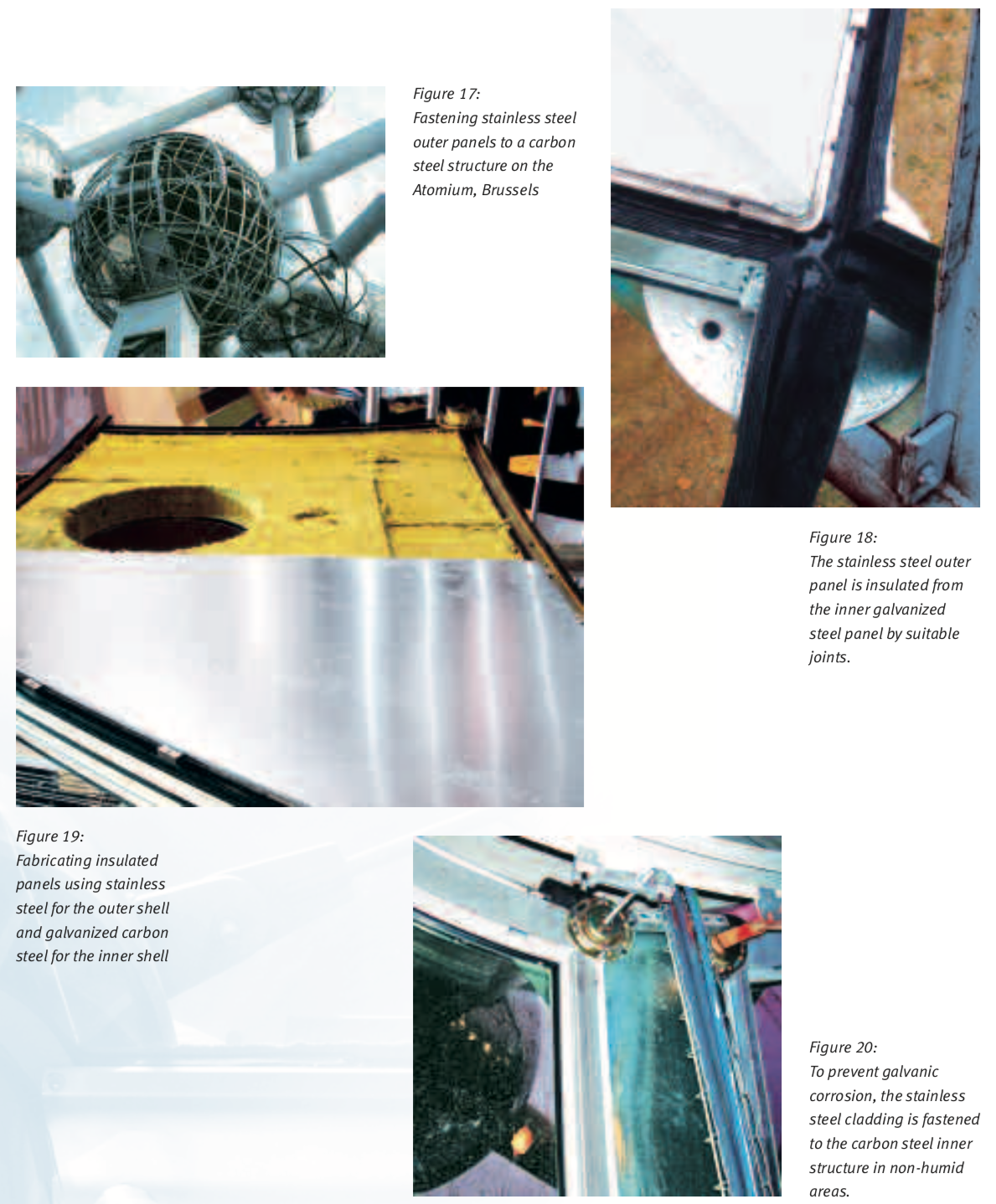
4.4 Stainless steel in transport applications
In passenger cars and other road vehicles, stainless steel (ferritic grades with a 12% to 18% chromium content and austenitic grades with about 18% chromium) is used for trim, exhaust systems (Figure 21), fuel tanks (Figure 22) and, increasingly, body and chassis components.
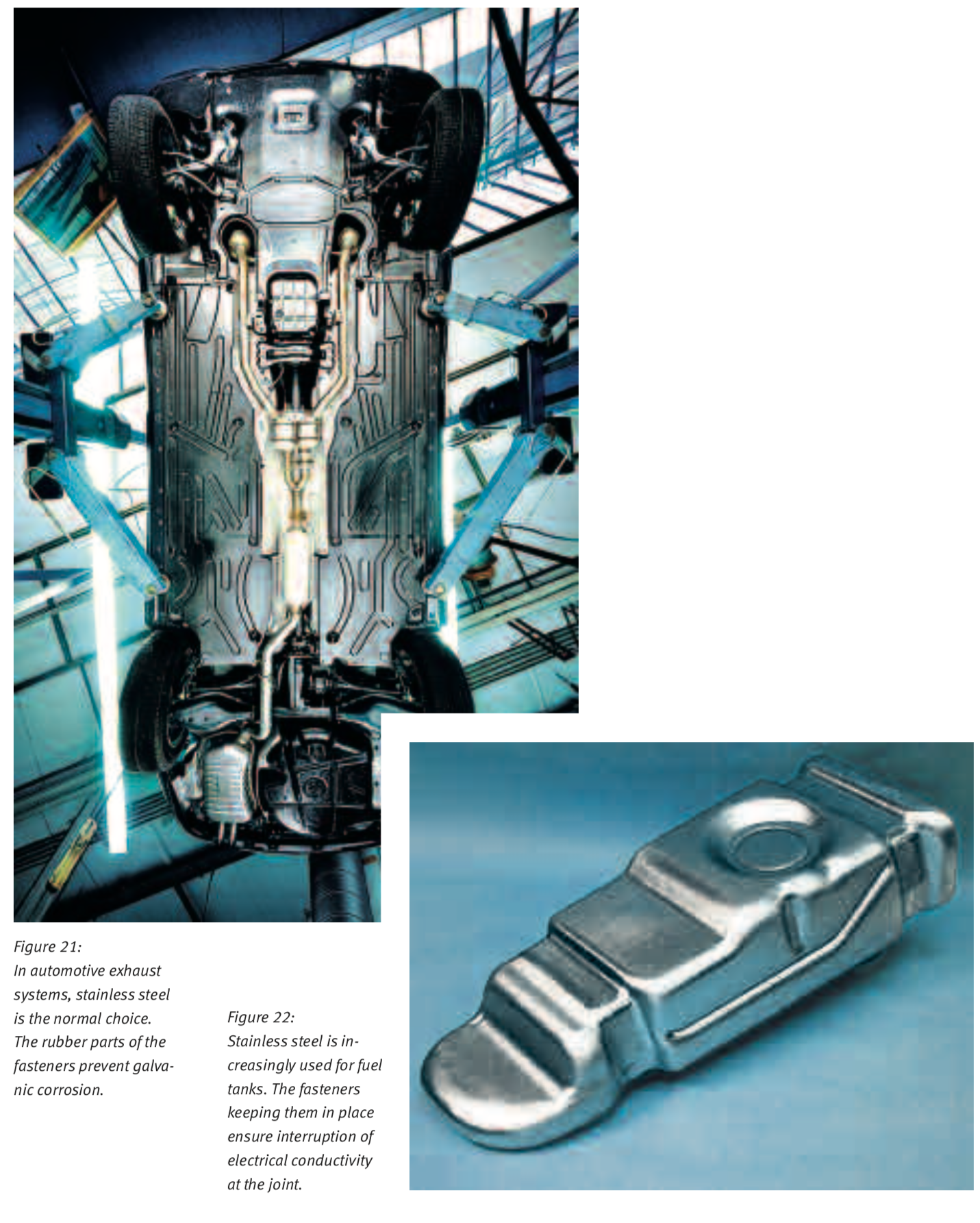
In transport applications, ferritic grades in combination with coatings are a common option (Figures 23, 24, 25). There is also a long tradition of austenitic stainless steels being used in rail coaches (Figure 26), in many parts of the world, without problems from galvanic corrosion.
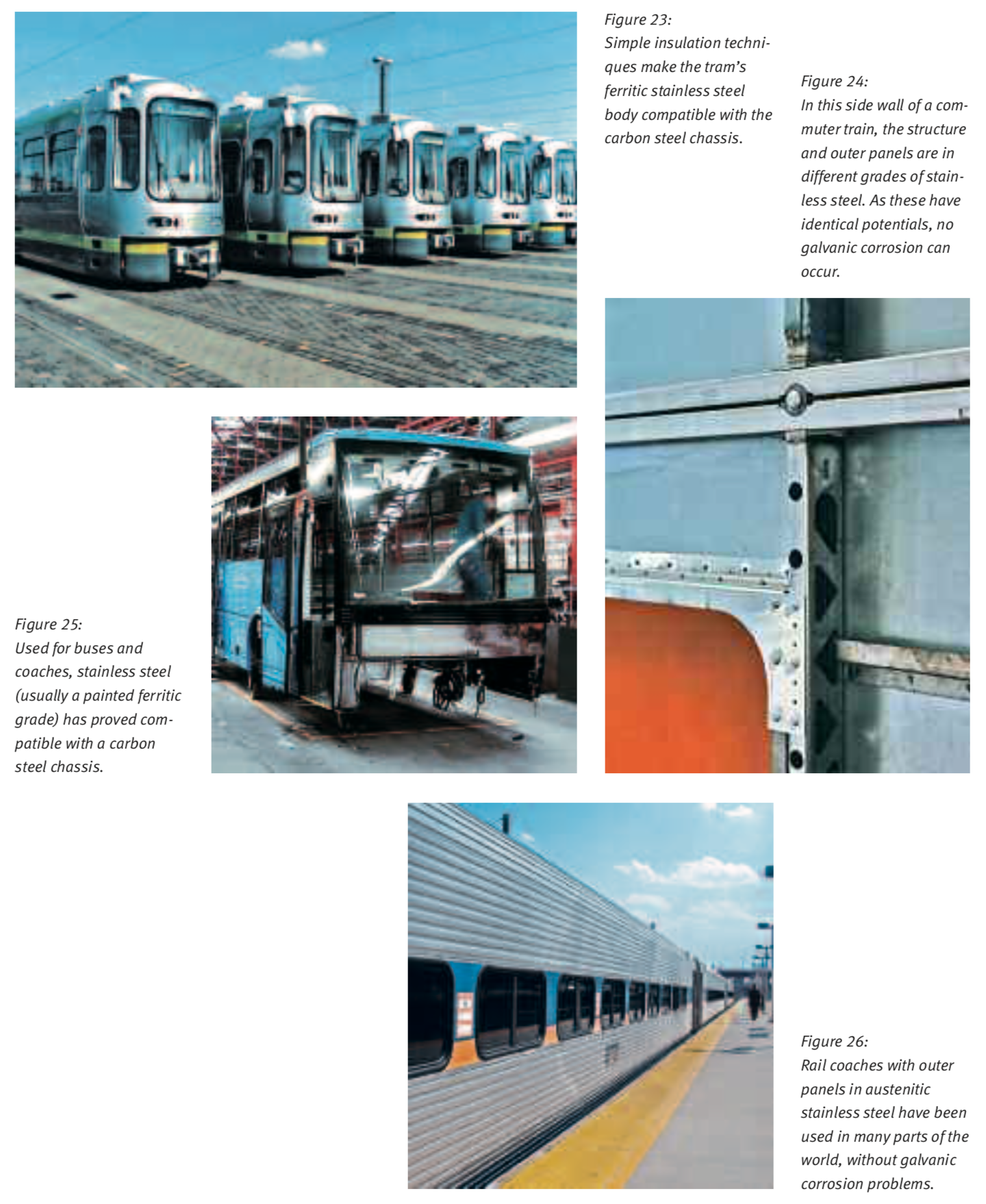
Here, too, it is essential to avoid crevices between stainless steel components and less noble materials, in which corrosive attacks can occur due to dirt and humidity. Once again, the crevices can be filled with a suitable polymer. Another effective precaution against galvanic corrosion in transport applications is the local coating of a contact zone on the stainless steel side, as described above.
4.5 Frequently Asked Questions
Question:
Is there a risk of galvanic corrosion if stainless steel grades of different chemical composition are joined?
Answer:
Between stainless steels of different types (also among different corrosion-resistance classes) there is generally no galvanic corrosion, as the free corrosion potentials of both partner metals are identical. However, the corrosion resistance of each alloy must be considered individually. Also the material with lower corrosion resistance must be sufficiently corrosion resistant in the conditions concerned (Figure 27).
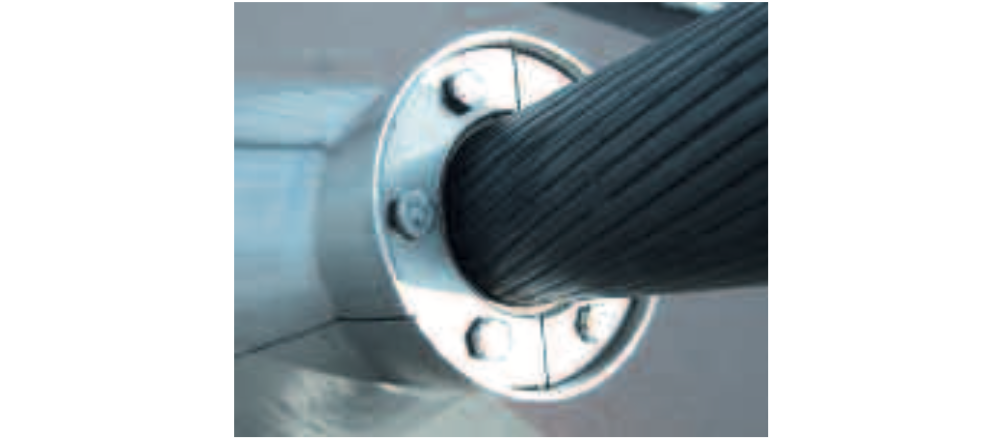
Question:
Can stainless steel be used in combination with copper or galvanized steel for the repair of domestic plumbing systems? Answer:
No problems are to be expected when stainless steel is combined with copper plumbing, as both materials have similar corrosion potential in potable water. Plumbing components made of hot-dip galvanized steel can also be combined with stainless steel. However, couplers of copper zinc alloys or red brass are recommended.
Question:
Can stainless steel rebar be joined with carbon steel in reinforced concrete?
Answer:
Yes, for carbon steel reinforcement, such a combination does not normally raise corrosion questions, as the corrosion potentials are identical. Such a combination can be used to prevent corrosion, when the reinforcement penetrates the concrete or comes into contact with tubes. The joint must be well within the concrete, with a minimum concrete cover of 3 cm. If the carbon steel rebar is in the active state (i.e. it is depassivated, due to the influence of chlorides and/or carbonation), galvanic corrosion is possible. However, in most cases, this effect is much less significant than that of the inevitable element formation between active and passive carbon steel rebar (galvanic corrosion through an active/passive element), since the cathodic efficiency of stainless steel is much lower than of carbon steel (Figure 28).

Question:
Are washers made of insulating polymers effective for preventing contact corrosion in mechanical joints?
Answer:
Although this joint does not interrupt metallic contact between the materials in the area of the thread, such washers can be
recommended, since the areas most at risk are additionally covered.
Question:
Can stainless steel infill for parapets be combined with carbon steel posts?
Answer:
If the design prevents an electrolyte (for instance rain or melting snow) forming over an extended period, such a direct contact is acceptable. Otherwise plastic bushes should be used.
5 Preventing galvanic corrosion
The obvious way to prevent galvanic corrosion is to select suitably compatible materials at design stage. If the materials that have to be used could interfere with each other, protective measures must be taken. Section 2 provides guidance on the nature of these measures. Figure 3 describes the practical possibilities:
- Electrical insulation of the components (insulators, plastic bushes or polyamide washers)
- Positioning of the joint in an area not exposed to humidity
- Coating a cathode or an anode and cathode (either on large surface areas or locally, near the joint).
It should be noted that just coating the anode is not a suitable way to prevent galvanic corrosion. Imperfection in the coating or local damage, which are difficult to avoid on-site, create a critical corrosion element: any damage to the coating exposes a small anode, which can then corrode rapidly.
To reduce the cathodic effect of the stainless steel part, it is often sufficient to coat the stainless steel around the joint (Figure 29). The width of the zone to be covered depends on the conductivity of the corrosive environment. In components exposed to normal room atmosphere and rather thin and weakly conductive electrolyte films, it is often sufficient to coat an area only a few centimetres wide along the contact line on the stainless steel side. In salty liquid films several millimetres thick, the effective cathode area becomes wider than 10 cm.
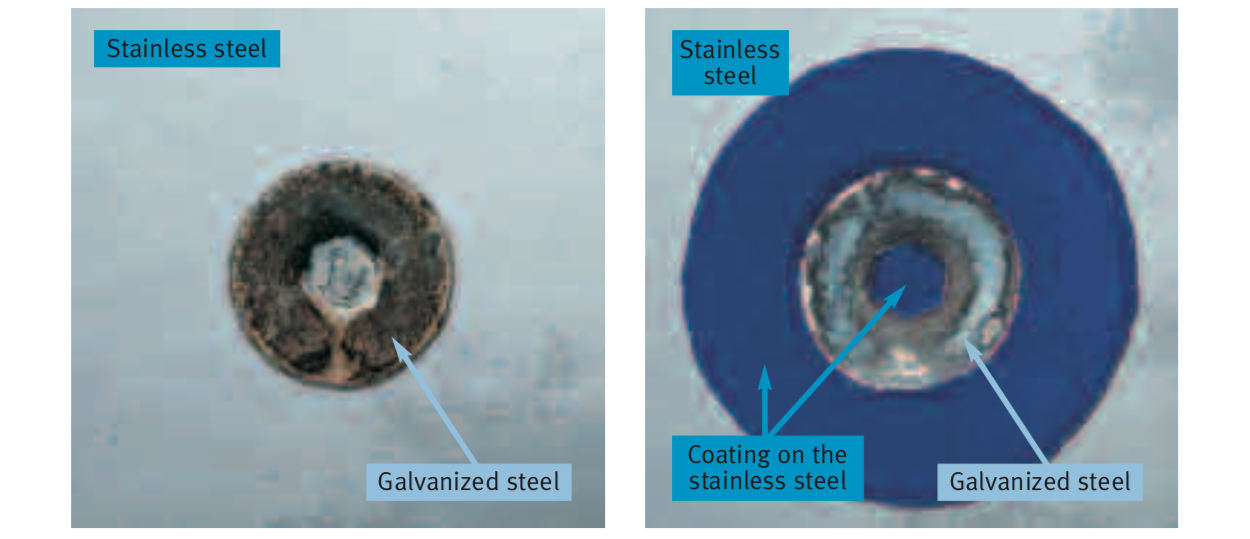
6 Literature
[1] DIN EN ISO 8044, Ausgabe:1999-11. Korrosion von Metallen und Legierungen – Grundbegriffe und Definitionen
[2] DIN EN 12502. Teil 1 bis 5, Ausgabe:2005-03 Korrosionsschutz metallischer Werkstoffe – Hinweise zur Abschätzung der Korrosionswahrscheinlichkeit in Wasserverteilungs- und Speichersystemen.
[3] H. Gräfen, ”Korrosionsschutz durch Information und Normung“ Kommentar zum DIN-Taschenbuch 219, Verlag Irene Kuron, Bonn (1988) S. 37.
[4] H. Spähn, K. Fäßler ”Kontaktkorrosion“ Werkstoffe und Korrosion 17 (1966) S. 321.
[5] D. Kuron. ”Aufstellung von Kontaktkorrosionstabellen für Werkstoffkombinationen in Wässern“. Werkstoffe und Korrosion 36 (1985) S. 173.
[6] D. Kuron, E.-M. Horn, H. Gräfen ”Praktische elektrochemische Kontaktkorrosionstabellen von Konstruktionswerkstoffen des Chemie-Apparatebaues“. Metalloberfläche 26 (1967) Nr. 2, S. 38.
[7] H. Spähn, K. Fäßler ”Kontaktkorrosion im Maschinen- und Apparatebau“. Der Maschinen Schaden 40 (1967) Nr. 3, S. 81.
[8] W. Schwenk, ”Probleme der Kontaktkorrosion“ Metalloberfläche 35, (1981) Nr. 5, S. 158.
[9] K.-H. Wiedemann, B. Gerodetti, R. Dietiker, P. Gritsch
”Automatische Ermittlung von Kontaktkorrosionsdaten und ihre Auswertung mittels Polarisationsdiagrammen“ Werkstoffe und Korrosion 29 (1978) S. 27.
[10] E. Hargarter, H. Sass ”Kontaktkorrosion zwischen verschiedenen Werkstoffen in Meerwasser“ Jahrbuch der Schiffbautechnischen Gesellschaft 80, (1986) S. 105.
[11] R. Francis, ”Galvanic Corrosion: a Practical Guide for Engineers“ NACE International (2001) Houston Texas 77084
ISBN 1 57590 110 2.
[12] GfKorr-Merkblatt 1.013 ”Korrosionsschutzgerechte Konstruktion” (2005).
[13] Allgemeine bauaufsichtliche Zulassung Z-30.3-6
”Erzeugnisse, Verbindungsmittel und Bauteile aus nichtrostenden Stählen“ (jeweils gültige Fassung) Sonderdruck 862 der Informationsstelle Edelstahl Rostfrei